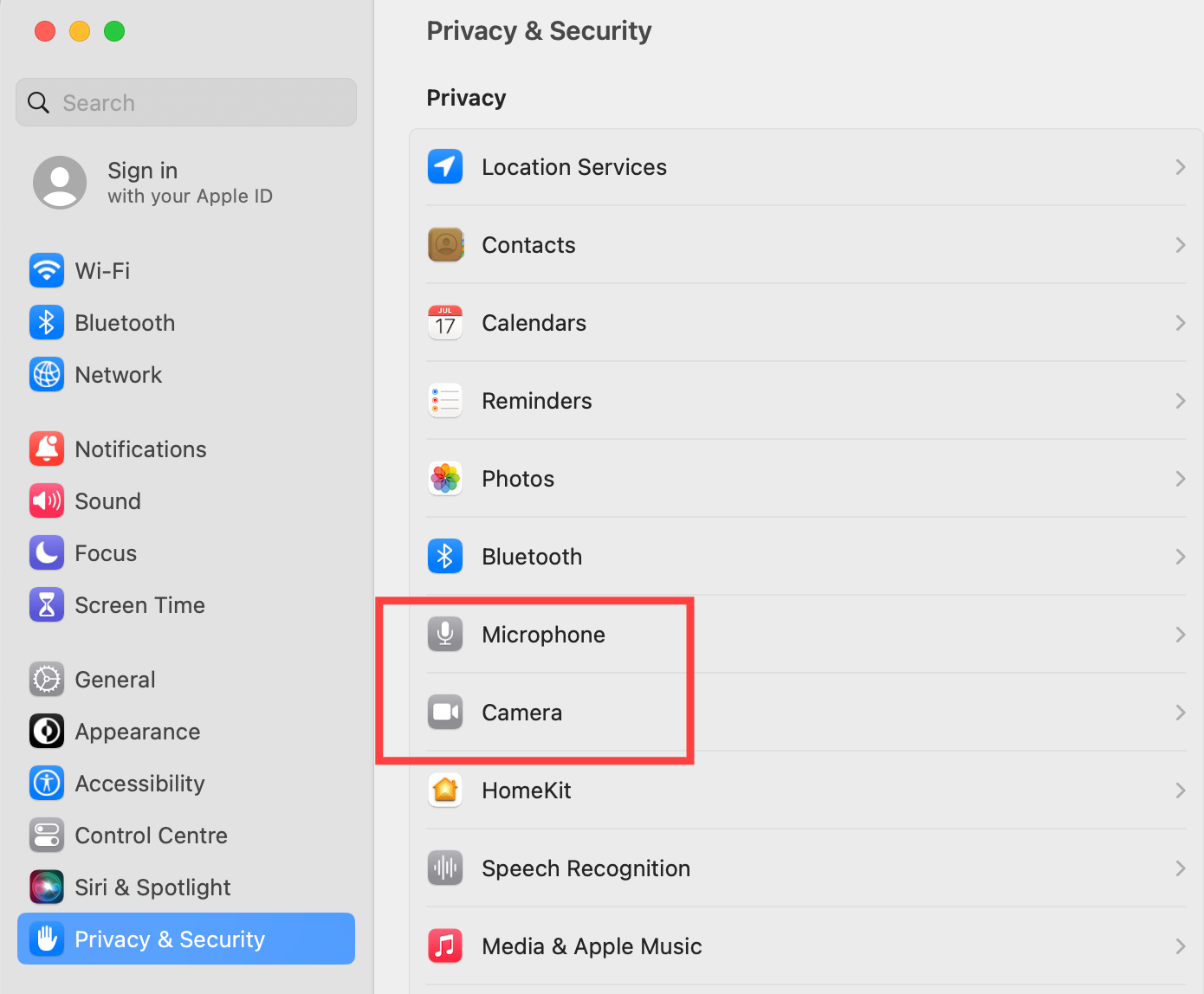Allowing camera and microphone access for Video Call
How to fix camera and/or microphone access issues detected for Video Call
Video Call requires access to your camera and microphone for a successful call. Patients and other callers using the clinic link will be asked to allow access when they Start a Video Call. If callers do not allow access, or if any camera or microphone issues are detected prior to getting into the call, for example when performing a pre-call test, the information below details how to resolve access issues.
Click on your device type for the relevant information:
Are you using and Apple iPhone or iPad?
1. Go to ‘Settings’ on your device  .
.
2. Search for 'Microphone' or ‘Camera’ in settings. Click on 'Microphone/Camera (In Privacy & Security).
3. Turn on Microphone and/or Camera access for your preferred browser using the toggle switch (Apple Safari, Google Chrome or Microsoft Edge).
Are you using an Android phone (for example a Samsung phone)?
1. Click on the clinic link to open your default browser, for example the Google Chrome app . Supported browsers are Safari, Google Chrome, Microsoft Edge or Mozilla Firefox.
. Supported browsers are Safari, Google Chrome, Microsoft Edge or Mozilla Firefox.
2. To the right of the address bar, tap More and then tap Settings.
3. Tap Site Settings.
4. Tap Microphone or Camera.
5. Tap to turn the microphone or camera on or off.
6. If you see the site you want to use under Blocked, tap the site and then choose Access your microphone (or camera) and then Allow
If the above steps do not fix your problem, you may have to change the permissions on your device:
1. On your device, open the Settings app.
2. Tap Apps.
3. Tap the Browser App (eg Chrome) you want to change. If you can't find it, tap See all apps. Then, choose Chrome.
4. Tap Permissions. If you allowed or denied any permissions for the Browser, you’ll find them here.
5. To change a permission setting, tap it, then choose Allow or Don't allow. Allow is the correct setting for Video Call.
Are you using an Apple computer (Mac)?
1.Click on the Apple menu at the top left corner of your screen > System Settings, then click Privacy & Security![]() in the sidebar. (You may need to scroll down.)
in the sidebar. (You may need to scroll down.)
2. Click Microphone or Camera in the list to the right.
3. Turn access to the microphone or camera on or off for your preferred browser in the list, using the toggle switch (Supported browsers are Safari, Google Chrome, Microsoft Edge or Mozilla Firefox)

Are you using a Windows computer?
- Click on the Video Call clinic link to open the default browser - either Google Chrome
 or Microsoft Edge
or Microsoft Edge 
- Click on the padlock
 symbol or
symbol or  in the web address bar to view the settings.
in the web address bar to view the settings. - Allow Camera or Microphone permissions if blocked OR follow the steps below to see detailed site settings:
More detailed site settings information:
- At the top right, click More
Settings.
- Click Privacy and security
Site settings
Camera or Microphone. OR search for 'Camera' / 'Microphone' in the Search bar.
- Select the option you want as your default setting.
- Review your blocked and allowed sites.
-
To remove an existing exception or permission: To the right of the site, click Delete
.
- To allow a site that you have already blocked: Under ‘Not allowed’, select the site's name and change the camera or microphone permission to 'Allow'.
If the above steps do not fix your problem, you may have to change the permissions on your device:
1. On your device, open the Settings app. (To open Settings, you can press the Windows key or click on the Windows icon in the bottom left corner of your screen and search for 'Settings')
2. Search for 'Camera Privacy Settings' or 'Microphone Privacy Settings'.
3. Turn on the setting for 'Let apps access your Camera' or 'Let apps access your microphone'.
4. If this setting is already turned on, turn it off and back on again.
5. Check the list of apps below and make sure your preferred browser is 'on' to access Camera/Microphone.
6. Restart your computer.
Microphone tips
To get the most out of your microphone, please see the information below:
- If you are using an external microphone, for example a USB microphone, check that it is plugged in correctly. You can try disconnecting and reconnecting the microphone as this can force your computer or device to recognise it.
- Ensure your microphone volume is set adequately, especially if you have volume control on your external headset.
- Ensure, there is no other software such as Teams or a video conferencing client open on your device that may be using your microphone. It is best to quit all other applications that access your microphone and camera when you are using Video Call.
- If you have a USB echo-cancelling combined microphone/speaker unit, make sure it is selected for use as both the microphone and speaker.
The above information should assist you to quickly and easily allow your camera and/or microphone. If required you can access more advanced information:
Click here for more advanced information regarding allowing your camera and/or microphone
Click here to access for more advanced information regarding pre-call test issues.